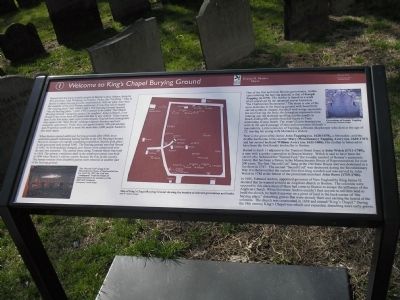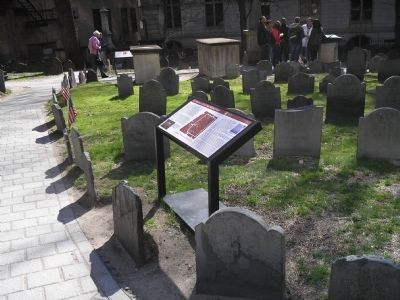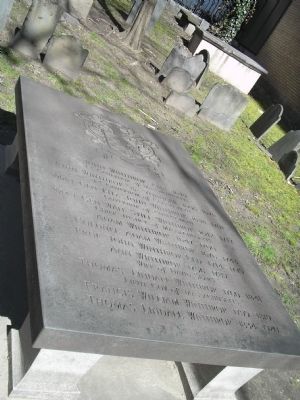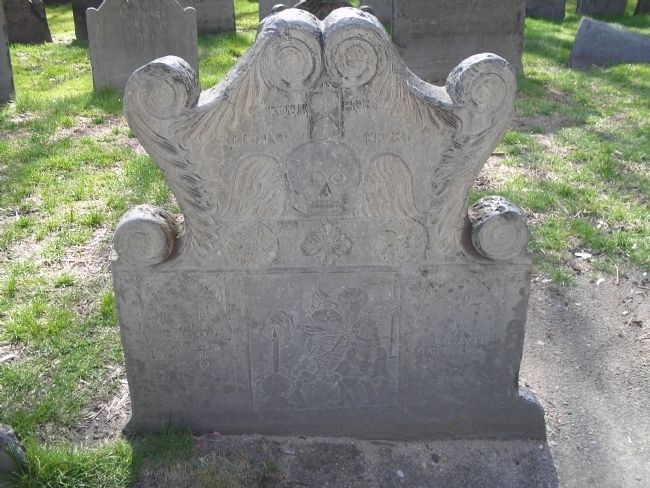Downtown in Boston in Suffolk County, Massachusetts — The American Northeast (New England)
Welcome to King’s Chapel Burying Ground
When Boston opened additional burying grounds after 1660, town selectmen passed ordinances barring burials at the Old Burying Ground. However, because of a rapidly expanding population, burials took place in the graveyard until around 1896. The burying ground was first fenced in 1642. As its boundaries changed, new fences were constructed over the next two centuries. The current fence along Tremont Street was built in 1854. The subway ventilation shaft in the southwest corner was built in 1896 when Boston’s subway system became the first in the country. The human remains from disturbed graves were reburied in another part of the burying ground.
One of the first and most famous gravestones, visible upon entering the burying ground, is that of Joseph Tapping (d. 1678). The marker is famed as a work of art conceived by the unnamed carver known as “the Charlestown Stonecutter.” The stone is one of the most elaborate in the burying ground with beautifully carved symbolic images: the skull with wings represents the soul leaving the body, the hourglass represents time running out, the skeleton snuffing out the candle is Death ending life, and the bearded figure is Time attempting to stop Death. The stone’s Latin inscriptions refer to the quick passage of time and awareness of death’s inevitability. Little is known of Tapping, a Boston shopkeeper who died at the age of 23, leaving his young wife Marianna a widow.
Next is the grave of his father John Rapping (ca. 1628-1678), a felt maker, and the double tombstone of his mother Mary (Woodmancy) Tapping Avery (ca. 1629-1707) and her second husband William Avery (ca. 1622-1686). His mother is believed to be have been the first female bookseller in Boston.
Buried in tomb 11 adjacent to the Tremont Street fence is John Welch (1711-1789), a man with a quirky connection to Boston history. Welch is said to have been the carver who fashioned the “Sacred Cod,” the wooden symbol of Boston’s economic history that has been a fixture in the Massachusetts House of Representatives for over 200 years. The first “Sacred Cod” hung at the Old State House and was destroyed in a fire there in 1747. The second “Sacred Cod” was destroyed during the Revolutionary War. It is believed that the current five-foot-long wooden cod was carved by John Welch in 1784 at the behest of the prominent merchant John Rowe (1715-1786).
In 1686, Edmund Andros, appointed governor of New England by King James II, decided that he wanted to build an Anglican church in Boston. The colonists were opposed to this since most of them had come to Boston to escape the influence of the Anglican Church. When Governor Andros couldn’t find anyone to sell him land to build the church, he built it anyway on a piece of land in the back corner of “the burying place,” disturbing graves that were already there and earning the hatred of the colonists. The church was consecrated in 1688 and named “King’s Chapel.” During the 18th century King’s Chapel was rebuilt and expanded, disturbing more early graves.
Topics. This historical marker is listed in these topic
lists: Cemeteries & Burial Sites • Colonial Era. A significant historical year for this entry is 1630.
Location. 42° 21.498′ N, 71° 3.602′ W. Marker is in Boston, Massachusetts, in Suffolk County. It is in Downtown. Marker is on Tremont Street, on the right when traveling north. Marker is located along the walking trail in King’s Chapel Burying Ground, near the entrance of the cemetery. Touch for map. Marker is in this post office area: Boston MA 02108, United States of America. Touch for directions.
Other nearby markers. At least 8 other markers are within walking distance of this marker. King’s Chapel Burial Ground (here, next to this marker); Pilgrims and Patriots (a few steps from this marker); William Dawes Jr. (a few steps from this marker); Life and Death in Colonial Boston (a few steps from this marker); The Chevalier de Saint Sauveur (a few steps from this marker); The First Governor (a few steps from this marker); Robert Keayne / Col. Nicholas Paige (within shouting distance of this marker); King's Chapel (within shouting distance of this marker). Touch for a list and map of all markers in Boston.
More about this marker. The top center of the marker contains a “Map of King’s Chapel Burying Ground showing the location of selected gravestones and tombs.” The upper right of the marker
features a photo of the Gravestone of Joseph Tapping, and the bottom left has a photo of “The ‘Sacred Cod’ hang[ing] in the Massachusetts House of Representatives. On April 26, 1933, the Cod was ‘codnapped’ from the House of Representatives by members of the Harvard Lampoon. All photos are courtesy of Viamonte Design.
Related markers. Click here for a list of markers that are related to this marker. Take a tour of the markers found in King’s Chapel Burying Ground.
Also see . . . King's Chapel and Burying Ground. Details of the Freedom Trail from the City of Boston website. (Submitted on May 14, 2009, by Bill Coughlin of Woodland Park, New Jersey.)
Credits. This page was last revised on January 30, 2023. It was originally submitted on May 14, 2009, by Bill Coughlin of Woodland Park, New Jersey. This page has been viewed 5,556 times since then and 58 times this year. Photos: 1, 2, 3, 4. submitted on May 14, 2009, by Bill Coughlin of Woodland Park, New Jersey.



